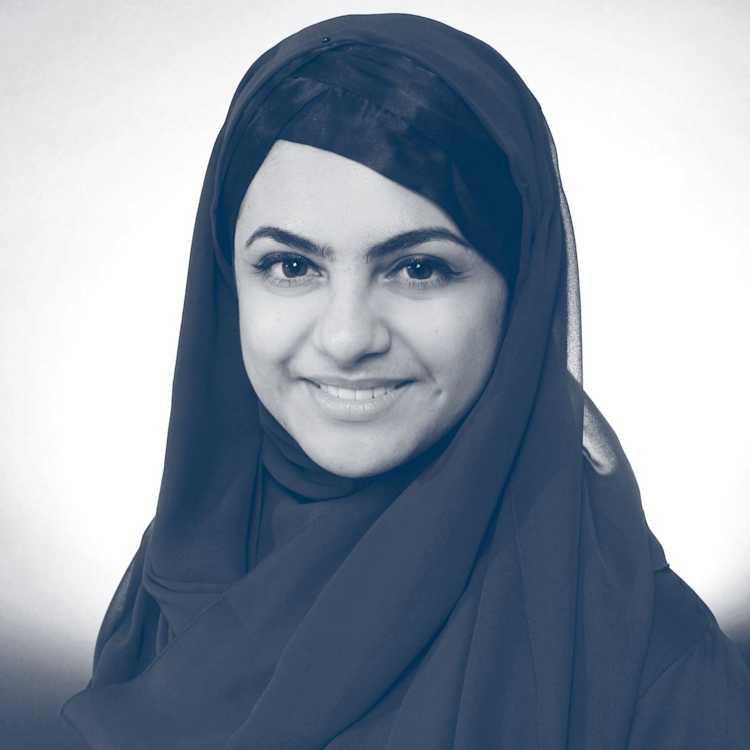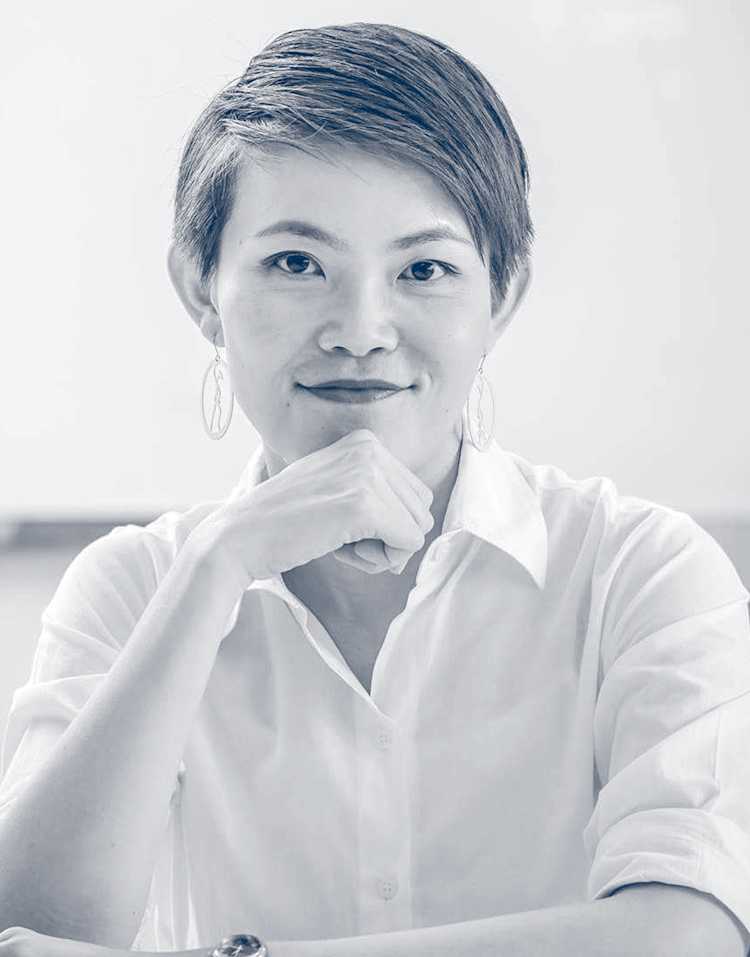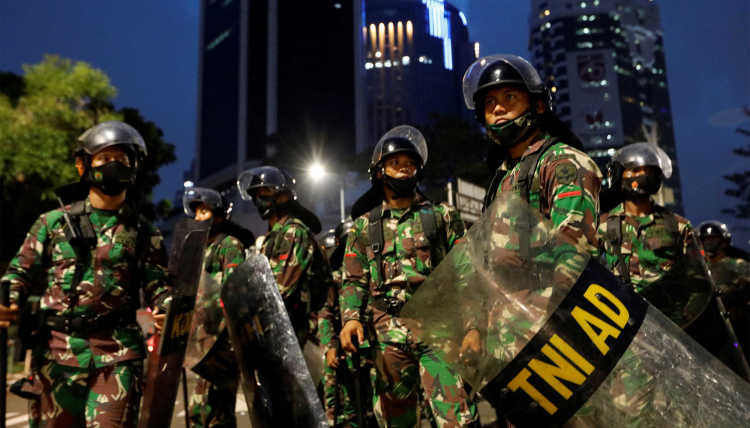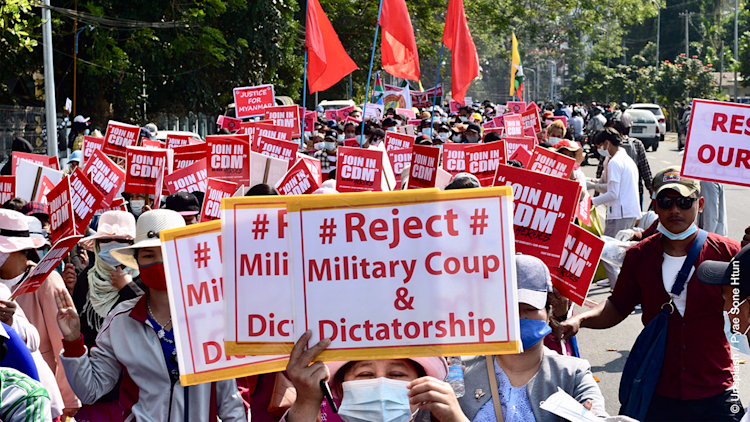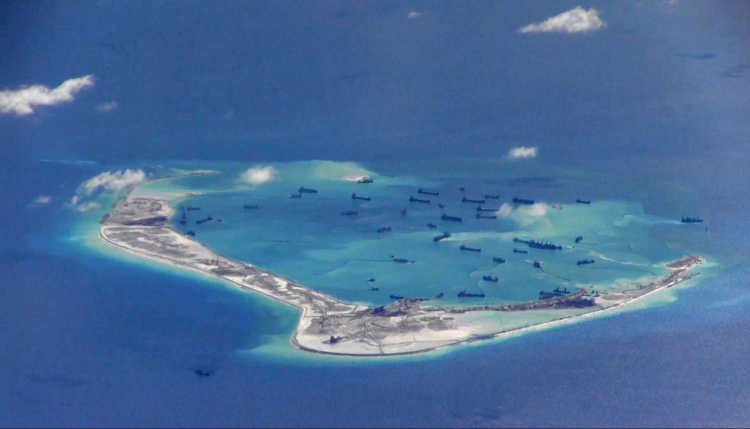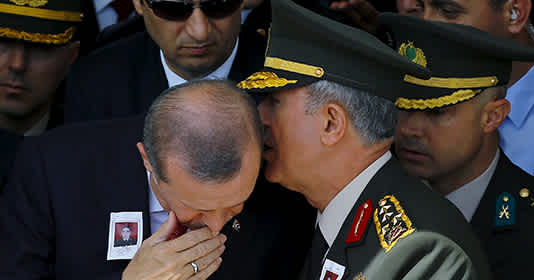- Home
- Publications
- GIGA Focus
- Egypt after the Arab Spring: A Legacy of No Advancement
GIGA Focus Middle East
Egypt after the Arab Spring: A Legacy of No Advancement
Number 7 | 2020 | ISSN: 1862-3611

Abdel Fattah el-Sisi came to power after the military ousted President Morsi in July 2013 following widespread protests and strikes. With the tenth anniversary of the Arab Spring uprising approaching, it has become clear that civil–military relations, infrastructure development, and population growth remain three interrelated challenges for Egypt that have persisted throughout the last decade.
The military is historically tied to politics and remains a highly popular institution in Egyptian society. Simultaneously, socio-economic grievances and its importance as an employer continue to push the military into Egypt’s domestic politics.
Infrastructure development is on a split course: On one hand, because of its resources and manpower, the military can invest in mega-projects in hopes of long-term economic benefits. On the other hand, urbanisation has remained stagnant due to the crackdown on booming illegal, albeit urgently needed, housing.
There is acknowledgement among policymakers that population growth is stifling infrastructure and development, yet there is little incentive for change. Measures targeting women fail to gain traction because of societal pressure to bear children, and because access to education, employment, and political participation remain unsafe given rampant sexual violence in public spaces.
Policy Implications
Through supporting socio-economic advancement in Egypt, Germany and the EU can facilitate the military’s withdrawal from politics over the long term. Active support for infrastructure development implemented by civilian actors will over time reduce the need for the military’s economic engagement. Improving women’s safety will enable their access to work and political participation, which in turn can lower birthrates more effectively than the provision of birth control alone.
Egypt after the Arab Spring: Three Points of Departure
Ten years since the start of the Arab Spring, Egypt has gone through periods of widespread unrest, general instability, and social changes. Economic grievances once drove people to protest in the streets, demanding social justice, dignity, and bread. Today, the same socio-economic grievances that sparked mass protests persist, with little prospect of improvement in the short to medium term. Egypt also continues to be one of the most densely populated countries on earth, its population having exceeded 100 million earlier this year. Taken together, these aspects represent important reasons for the military’s recurring involvement in domestic politics. The Egyptian Army ousted President Mohammed Morsi in 2013 by coup d’état. Previously, it had defected from Morsi’s predecessor, Hosni Mubarak, eventually ousting the Mubarak regime.
Socio-economic grievances, steep population growth, and militarised governance are three central challenges that continue to drive Egypt’s trajectory and threaten its prospects of democratisation. But because these challenges remain pervasive, it is important to investigate not only how they have changed since Abdel Fattah el-Sisi came to power, but also how they impact each other. Population growth not only amplifies many of the existing socio-economic grievances – it is also a product of them. In the absence of social security and eldercare schemes, families continue to rely on children for survival and as future providers. The existing, oversaturated labour market cannot absorb the abundance of young people, leaving many unemployed. Women suffer under immense societal pressure to bear children and do not have safe access to education and employment given rampant sexual violence towards them in the public space. Additionally, Egypt has a pronounced male youth bulge, which is of direct relevance for civil–military relations. Soldiers join and stay with the military to escape poverty and unemployment, sharing the same grievances as the civilian population. Because the make-up of the Egyptian military itself reflects underlying societal grievances, it is more and more rendered an independent political actor with responsibilities and alliances to each the regime and the people, making structural disentanglement from politics onerous.
The Role of the Military: Moderniser, Ruler, and Employer
An important starting point in disentangling Egyptian politics is civil–military relations. Military meddling in civilian affairs has been a recurring issue in the MENA region for decades. Maintaining balanced civil–military relations is crucial for long-term prospects of democratisation because civilian supremacy – meaning a military completely subordinate to civilian rule – constitutes a fundamental prerequisite of democracy. The coup in the summer of 2013 that ousted Egypt’s first civilian president was preceded by a long history of military involvement dating back to colonial independence gained through a military coup by Gamal Abdel Nasser in 1952. With the exception of Mohammed Morsi, in fact, all Egyptian heads of state have had a military career. This reflects that political mingling is written into the institutional make-up and understanding of Egyptian military professionalism. However, military entanglement can also be driven by infrastructural and developmental needs, unemployment, and absence of welfare, as the decade since the Arab Spring exemplifies.
Understanding of Egypt’s civil–military relations in the West is often limited to political representation, such as the head of state’s previous military career or appearance in uniform, post-military political careers, or direct interventions into civilian politics in the form of coups d’état. But coups indicate only that civilian oversight has already broken down, and do not necessarily offer insight into the causes and process of this breakdown. From the 1950s to today, Egypt remains a peculiar case with regards to military entanglement in civilian affairs, with little prospect of change. Data from the Arab Barometer in Egypt further highlights that the military enjoys relatively high levels of trust and confidence among the population compared to the government, parliament, judiciary, and the police, even after an overall decline post-2011 (Arab Barometer 2020).
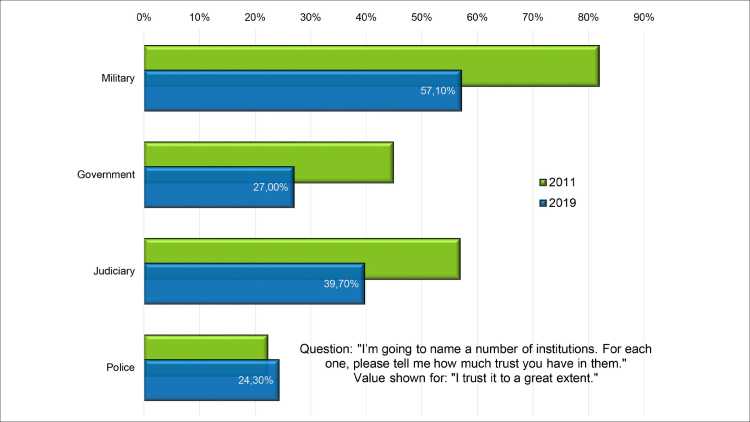
There is little consensus in the broader defence economics literature about military impact on industrial development and socio-economic advancement. On one hand, it is touted as driver of modernisation through spin-offs and skill transfer, especially with regards to engineering and inventions, when the army operates at a higher manufacturing standard than the civilian industry in a given country. On the other hand, increased prioritisation of military production and expenditure often goes at the expense of spending on health, education, and welfare services. In Egypt, the military remains an important player in infrastructure and the economy. Under Sisi, the Egyptian Army, building on its long history of entrepreneurialism, expanded its business practices further, even signing deals with foreign firms (Al-Mary Al-Youm 2020). Furthermore, the military also produces solar panels, chemical compounds, and computer circuits, and runs motor companies (Al-Masry Al-Youm 2020). The Ministry of Military Production also lists their other, civilian-oriented products, ranging from smaller household items to industrial machinery.
With continued unemployment, now also fuelled by the COVID-19 pandemic, the military has emerged as a comparatively stable employer, offering pensions and insurance and providing social welfare, which are all especially relevant benefits given the absence of this service provision by the civilian government, overall decreased tax revenues (World Bank 2020), and the collapse of the tourism sector since the Arab Spring. Through amendments to military retirement law (Egypt Today 2020), military pension payments have even been increased a few times under Sisi, such as in 2015 (Al-Masry Al-Youm 2015) and as recently as April 2020. Additionally, widespread poverty pushes primarily young men to remain with the military beyond conscription, further adding to its manpower and socio-economic relevance.
Historical legacies and therefore precedent and experience in policymaking continue to draw Egyptian armed forces into the political arena. At the same time, the military is pushed into the political sphere due to infrastructural demands and grievances that threaten to destabilise the country. Civil–military relations in Egypt encompass more than just the military’s political representation. Between Mubarak and Sisi, entangled civil–military relations have remained a constant, as have the widespread popularity of and trust in the military. High military approval rates not only increase its socio-political importance in politics, but also foster a sense of responsibility and loyalty to the civilian society that is distinct from the military’s relationship to the regime itself. Paradoxically, the imbalance in civil–military relations continues to be driven by the very same grievances that drove people to mass protests to oust the Mubarak regime in 2011. One of these issues is infrastructural development, or more specifically, the housing needs of an ever-growing population.
Infrastructural Changes: Between Mega-Projects and Demolitions
After coming into power, Sisi’s regime promised big changes to a country still in uproar over grievances on every level and strikes in every sector of the economy. The phenomenon of introducing mega-projects or big reforms after coming to power is almost traditional in Egypt: Nasser is associated with the construction of the Aswan Dam and the nationalisation of the Suez Canal, Anwar al-Sadat is credited with economic openings, and Mubarak with big neoliberal reforms, road constructions, and phone circuits. Sisi’s administration has similarly launched mega-projects, including the further development of the Suez Canal Zone, the erection of the Grand Egyptian Museum in Giza, and the construction of a new desert capital city east of Cairo, a project launched in 2015. Currently, the Ministry of Defence and the Egyptian military also list other national projects on their websites, including the construction of wheat storage silos, cross-country motorways, hospitals, and bridges, along with general urban development of slum areas.
In general, infrastructural development in Egypt under Sisi is torn in different directions in an unprecedented way. Demographic growth in Egypt is pushing the need for accessible housing while straining existing infrastructure, basic utilities, and public transportation. Since the end of the Arab Spring, Egypt has seen another boom in illegal housing. This problem is propelled by an urban population that is densely concentrated around a relatively small strip of land. Since 2011, builders have exploited the post-Arab Spring chaos, building apartment complexes without obtaining official permits or abiding by security measures (Alsharif 2014). To regularise these illegal buildings, citizens must pay steep fees. Sisi’s government has put forth a deadline for this year by which citizens must legalise their buildings or face demolition, the ostensible reason being to conserve arable land (Abdel Ghany 2020). As the civilian government is cracking down on illegal housing, it has not been able to meet urgent demands for affordable housing against the backdrop of continued economic crises. Housing complexes are urgently needed, and the demolition of these (albeit illegal) units leaves people homeless or struggling to find the resources to pay for required permits and fees. However, as building blocks are erected, the electrical grid has seen fewer upgrades, resulting in frequent to almost daily blackouts. Likewise, road and traffic conditions remain chaotic.
At the same time, the military continues to invest in mega-projects because it has the resources, manpower, and expertise to implement these projects. But this approach leaves little space for civilian oversight or formalised accountability vis-à-vis civilian demands. Moreover, while cross-country motorways or the Suez Canal Development Project will likely benefit the economy in the long term, they offer few short-term pay-offs to the average Egyptian in need of a roof over their head. Mega-projects attract foreign investors, are internationally visible, and create some employment. The symbolism attached to such projects plays an important role in domestic politics, helping secure approval and legitimacy, especially given continued economic grievances that may provoke civil unrest. Against this backdrop, the expansion of the Suez Canal almost seems like a deliberate nod to Nasser’s nationalisation of the same canal in 1956.
When looking far into the future in hopes of a long-term economic upturn, immediate housing needs and current economic crises are easily overlooked – which ultimately stifles long-term pay-offs as well. Given the rapid growth in population, keeping up with housing demands becomes a priority of unforeseen urgency that continuously draws the military into the political sphere. The effect of such mega-projects remains highly ambivalent: their implementation may on short notice help the agent implementing them to gain political legitimacy, but at the same time it may undermine that legitimacy in the long run. Mega-projects might offer some pay-offs in the future – but unless grievances in the present are also addressed, that future will remain out of reach.
Demography and Gendered Challenges
A latent issue in Egypt is outsized population growth on a relatively small strip of land. As of this year, Egypt’s population exceeded 100 million (see Figure 2) and has been skewed towards younger cohorts for decades. The problem of Egypt’s population growth existed long before Sisi’s regime, and there is little indication that it is likely to change soon. This population growth, however, stands within a specific socio-economic context that needs to be considered. Raging inflation and unemployment have persisted through the Arab Spring to today, with little prospect for improvement in sight. Urban design and infrastructure projects are presently characterised by either the immediate need to house the ever-growing population with little space available, or the need to secure political approval and avoid unrest. Very few investments in public spaces are not focused on living, commuting, trade, and basic infrastructure such as sanitation, which comes at the expense of parks and other recreational spaces. In a similar vein to physical living conditions, the civilian government also continues to struggle with providing social security and welfare services to the continuously growing population.
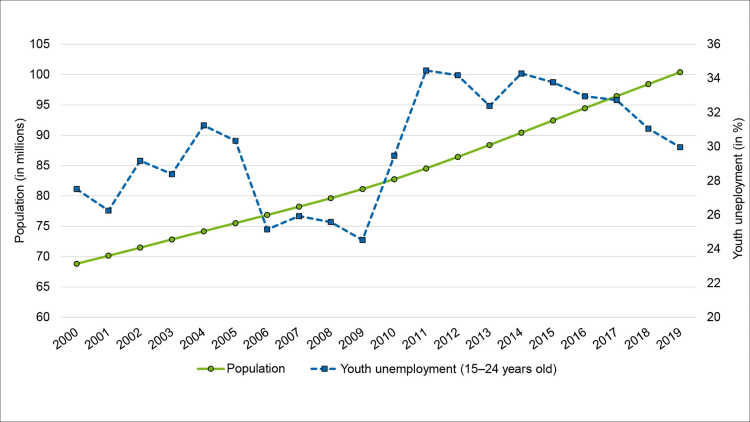
Some attempts have been undertaken by the current administration to encourage family planning and provide contraception and education, especially in rural areas (Awadallah 2017). Sisi has repeatedly stated that, alongside terrorism, demographic challenges pose the biggest threat to Egyptian national development, with his government launching a campaign in 2019 advocating that two children are enough (Masri 2019). Presently, the fertility rate in Egypt is approximately 3.3 births per woman (World Bank 2020). Egypt’s population is not only young and heavily skewed towards younger cohorts, but there is also a pronounced bulge in both male and female cohorts between 19 and 25. The distribution of age cohorts, rather than just the total population alone, has socio-political implications. Populations with male youth bulges are associated with more political violence, especially in combination with the presence of economic grievances; a large surplus in the labour force cannot be absorbed by an oversaturated labour market, a situation that contributes to youth unemployment (Urdal 2012).
Employment and job prospects – especially among the youth – have seen little improvement (see Figure 2) even as those who do complete tertiary-level education find themselves unemployed (Habibi and Hamidi 2016). And yet, population growth remains relentless, raising the question of what drives it and how it impacts existing grievances. In the absence of social welfare and pensions, families tend to invest in children as a social security plan. At the same time, education remains inaccessible and underfunded, which dampens prospects of social mobility beyond mere survival. Appeals regarding family planning therefore remain ineffective, because there is little incentive to not rely on children, even though family may ensure little beyond mere survival and some form of eldercare. Simultaneously, gendered and other societal pressures are driving family planning despite continued grievances. In Egyptian society, women and men are often not considered as full adults unless they are married and – especially for women – have children. Across social strata, women’s social status remains conditional on their reproductive capability. Meanwhile, these pressures clash with the reality of high living costs and unaffordable living spaces that prevent youths from realising their family planning (Singerman 2013). This mismatch likely feeds into the desirability of children: precisely because not everyone can afford to get married and support a family, having children is a conveyor of social status in families that are financially well-off, or is presented as a divine blessing (rizq or baraka) despite hardship in poorer families.
The specifically male youth bulge in turn plays a role in the military’s political bargaining; underlying socio-economic problems in society are also reflected in the military itself, as the military conscripts from the general population. As outlined in the Arab Barometer, the Egyptian military continues to be highly popular with the people. It is well known in Egyptian society that Nasser and Sadat both came from poor families in rural Egypt, ascended through the military ranks, and introduced redistributive policies. Coupled with continued popularity, rising through the military ranks is widely seen as a chance at upward social mobility, which draws especially young men into the military beyond conscription. Low- to mid-ranking recruits therefore often share the same grievances as the civilian population, as many men remain in the army beyond conscription to escape poverty. The defection from Mubarak in 2011 and the coup in 2013 were both preceded by popular demand that the military side with protesters and oust the current regime. These instances demonstrate that, in Egypt, regime and military are not a unitary agent – rather, the military maintains its own relationship to citizens and can act independently from the regime. Shared grievances among soldiers and citizens likely foster a sense of responsibility and loyalty towards citizens over the regime. The regime defections in the past therefore underscore that military relations towards civil society should not be underestimated and will gain relevance the more men join the army to escape from poverty.
Policymakers and international organisations in the past have frequently addressed Egypt’s overpopulation and proposed a variety of measures aiming to reduce birth rates. Yet measures targeting women that are usually associated with lowering the birth rate – such as in the realms of education, employment, and healthcare – have not gained traction in Egyptian society. While education in general is inaccessible and ineffective with regards to employment prospects, these challenges affect women to a greater extent. Access to employment begins with women’s safety – on their commutes to work and in any public space. Sexual assault and sexualised violence towards women, often politically motivated, has increased greatly since the Arab Spring (Grove 2015; Tadros 2013). Ongoing gendered violence in the public space not only discourages women’s participation in public life and politics, but also confines them to their homes, whether because they choose to stay home or because they are kept home by their families. Ensuring availability of birth control will also not gain traction without an underlying medical infrastructure and regular access to healthcare beyond basic reproductive services.
As long as there is little prospect of social security and pensions being provided, incentives to raise children as a means to secure future social security will continue to be pervasive. Likewise, repeated appeals to use contraception will not gain traction if societal prestige and reputation remain conditional on family status, especially for women. Rather than discouraging people from having children, economic grievances are more likely to raise overall political dissatisfaction and political tension. Poverty and unemployment will also continue to draw young men into the army, which inadvertently strengthens the military’s political influence, bargaining power, and socio-economic significance in Egypt. And lastly, infrastructural development will remain torn in different directions as long as population growth continues. Demographic developments, therefore, should not be seen outside their socio-economic context, but rather as both a result and a driver of those same circumstances.
In summary, Egypt’s overpopulation is an almost tautological problem. Infrastructural needs and grievances are high because of Egypt’s high birth rate, but Egypt continues to have a high birth rate at least in part because of those grievances. The population’s specific make-up not only strains the labour market but also impacts the army’s relations with the regime vis-à-vis the people. Not only do civilians appeal to the army to step into politics on their behalf on the grounds of shared grievances, but the army itself may be inclined to maintain loyalty to the people as protector and arbiter because of soldiers’ socio-economic descent and the military’s overall popularity among the people.
Sisi’s Egypt: Haunted by the Past
For foreign policymakers in Germany and the European Union it is important to understand that Egypt’s long path to stability and democratisation begins not with elections, but rather with balancing civil–military relations and mitigating socio-economic grievances that most likely require military manpower. Measures to tackle population control must include ensuring women’s safety in public spaces given the unbridled sexual violence that bars them from accessing education and employment, which ultimately reduces the effectiveness of measures that have already been taken to address population growth.
Overpopulation, slow infrastructural development, and unbalanced civil–military relations have existed in previous regimes but have worsened since the Arab Spring and will likely persist over the next decade. Overall, Sisi’s Egypt is haunted by its past. The main challenge going forward will therefore not just be to turn the corner, but to make any dent at all. Egypt remains an important partner to Germany and the European Union, as well as an important ally to NATO in the “War on Terror” and a geostrategic partner in the Middle East and North Africa. Critique regarding domestic civil–military relations from European stakeholders is often hyper-focused on the political representation of the armed forces with little understanding of socio-economic factors pushing or pulling the military into politics. Future democratic growth in Egypt is conditional on breaking the cycle between economic grievances and military inference. Herein it is crucial for European policymakers to put aside Westernised ideals of what democratisation should look like under conditions of full civilian supremacy, because these ideals have simply never corresponded with the reality of Egyptian politics. The Egyptian military’s long history of leaving and returning to the barracks since the country’s colonial independence has ingrained it into Egypt’s institutional framework as a constant political agent, a fact that is unlikely to change in the near future. Societal structures and grievances are reflected in the army’s recruits, creating a semblance of political representation and loyalty towards the Egyptian people, which in turn detaches it from the regime and influences political bargaining between incumbent regime, opposing elites, and citizens.
Understanding this circular dynamic is crucial for future decision-making with regards to developmental aid and foreign investments, especially in infrastructure projects. German policymakers can facilitate a military withdrawal from politics by mitigating the factors most likely drawing the military into politics. Active encouragement of foreign investment in favour of civilian actors in infrastructural development, including improving electrical grids, road conditions, and public transportation safety, not only lessens the need for military manpower to undertake these tasks in the long term, but also enables women’s safe and regular access to the labour force and political participation. In a similar vein, support for a welfare infrastructure will lessen the need to depend on many children as a means of social security and eldercare.
Shortcomings in infrastructure and urban development are amplified by population growth. To break the vicious cycle of population growth and socio-economic grievances, European policymakers must pay particularly close attention to Egyptian women’s safety and well-being to ensure not only their political participation, but also their access to education, employment, and healthcare. Egypt’s population growth is not just an exacerbator of grievances and lack of welfare but is also a product of them. Measures already taken by Germany and the EU will continue to fail to gain traction if surrounding grievances are not mitigated. Improving road conditions and public transportation not only supports overall infrastructural development, but also contributes to increasing women’s safety on Egyptian streets. Sexualised violence is a central factor keeping women away from education and the labour force and preventing them from equally partaking in public life and political representation, which limits their societal role to reproduction and domestic labour. Educating women as a means to reduce rates of childbirth must therefore be accompanied by educating men and specifically male political stakeholders about women’s rights and family planning, as well as training law enforcement in effective prosecution of sexualised violence. Germany and the European Union should therefore not limit measures to counter population control to the mere provision of contraception and related education to girls and women.
Under these circumstances, withdrawing aid and limiting ties with Egypt as a punitive measure because of population growth or the military’s political role – both century-old issues – will do far more damage than good to the people of Egypt, particularly Egyptian women. To find a way forward in Egypt means to first find a way out of the military/grievance loop and to defuse the urgency of infrastructural needs by enabling women to partake in societal life beyond their role as childbearers. Otherwise, Egypt’s past will continue to haunt its future.
Footnotes
References
Abdel Ghany, Mohamed (2020), Egyptians Struggle as Authorities Crackdown on Illegal Housing, 5 October, www.aljazeera.com/features/2020/10/5/egyptians-struggle-as-authorities-crackdown-on-illegal-housing (10 December 2020).
Al-Masry Al-Youm (2020), Sisi Opens New Factories Under Ministry of Military Prodiction, 18 February, https://egyptindependent.com/egypts-sisi-opens-new-factories-under-ministry-of-military-production/ (10 December 2020).
Al-Masry Al-Youm (2015), Sisi Increases Military Pensions, 29 June, www.egyptindependent.com/sisi-increases-military-pensions/ (10 December 2020).
Alsharif, Asma (2014), Illegal Housing Boom is Big Challenge for Egypt’s Leader, 28 April, https://www.reuters.com/article/us-egypt-election-housing-idUSKBN0DE14O20140428, (10 December 2020).
Arab Barometer (2020), Survey Data on Egypt from AB Wave II (2010–2011) and AB Wave V (2018–2019), www.arabbarometer.org/survey-data/ (10 December 2020).
Awadalla, Nadine (2017), Egypt Promotes Birth Control to Fight Rapid Population Growth, 30 August, www.reuters.com/article/us-egypt-population-idUSKCN1BA153 (10 December 2020).
Egypt Today (2020), Sisi Approves Amendmends to Egyptian Military Retirement Law, 19 April, www.egypttoday.com/Article/1/84896/Sisi-approves-amendments-to-Egyptian-military-forces-retirement-law (10 December 2020).
Grove, Nicole Sunday (2015), The Cartographic Ambiguities of HarassMap: Crowdmapping Security and Sexual Violence in Egypt, in: Security Dialogue, 46, 4, 345–364.
Habibi, Nader, and Fatma El Hamidi (2016), Why are Egyptian Youth Burning their University Diplomas? The Overeducation Crisis in Egypt, Brandeis University Working Paper No. 102, September, 1–10.
Masri, Lena (2019), “Two is enough,” Egypt Tells Poor Families as Population Booms, 20 February, https://de.reuters.com/article/uk-egypt-population-idAFKCN1Q91UI (10 December 2020).
Singerman, Diane (2013), Youth, Gender, and Dignity in the Egyptian Uprising, in: Journal of Middle East Women’s Studies, 9, 3, 1–27.
Tadros, Mariz (2013), Politically Motivated Sexual Assault and the Law in Violent Transitions: A Case Study from Egypt, Brighton: Institute of Development Studies (IDS).
Urdal, Henrik (2012), Youth Bulges and Violence, in: Jack A. Goldstone, Eric P. Kaufmann, and Monica Duffy Toft (eds), Political Demography. How Population Changes Are Reshaping International Security and National Politics, Boulder, London: Paradigm Publishers, 117–132.
World Bank (2020), Data Egypt, Arab Republic, https://data.worldbank.org/country/egypt-arab-rep (15 December 2020).
General Editor GIGA Focus
Editor GIGA Focus Middle East
Editorial Department GIGA Focus Middle East
Regional Institutes
Research Programmes
How to cite this article
Ali, Hager (2020), Egypt after the Arab Spring: A Legacy of No Advancement, GIGA Focus Middle East, 7, Hamburg: German Institute for Global and Area Studies (GIGA), https://nbn-resolving.org/urn:nbn:de:0168-ssoar-71083-9
Imprint
The GIGA Focus is an Open Access publication and can be read on the Internet and downloaded free of charge at www.giga-hamburg.de/en/publications/giga-focus. According to the conditions of the Creative-Commons license Attribution-No Derivative Works 3.0, this publication may be freely duplicated, circulated, and made accessible to the public. The particular conditions include the correct indication of the initial publication as GIGA Focus and no changes in or abbreviation of texts.
The German Institute for Global and Area Studies (GIGA) – Leibniz-Institut für Globale und Regionale Studien in Hamburg publishes the Focus series on Africa, Asia, Latin America, the Middle East and global issues. The GIGA Focus is edited and published by the GIGA. The views and opinions expressed are solely those of the authors and do not necessarily reflect those of the institute. Authors alone are responsible for the content of their articles. GIGA and the authors cannot be held liable for any errors and omissions, or for any consequences arising from the use of the information provided.




